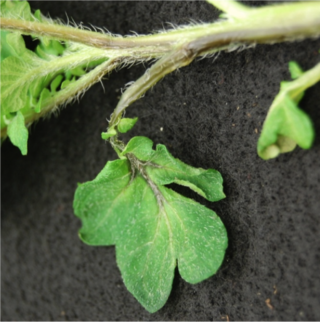
Gemmatimonas aurantiaca is a Gram-negative, aerobic, polyphosphate-accumulating micro-organism. It is a Gram-negative, rod-shaped aerobe, with type strain T-27T. It replicates by budding.
Dickeya is a genus of the family Pectobacteriaceae that consists mainly of pathogens from herbaceous plants. Dickeya is the result of the reclassification of 75 strains of Pectobacterium chrysanthemi, as well as Brenneria paradisiaca CFBP 4178, into a new genus. The genus is named for American phytopathologist Robert S. Dickey. Several species in this genus, such as Dickeya dadantii, are known phytopathogens.
Streptomyces europaeiscabiei or is a streptomycete bacterium species that is associated with common scab in potatoes. Its type strain is CFBP 4497T.
Streptomyces stelliscabiei or is a streptomycete bacterium species that is associated with common scab in potatoes. Its type strain is CFBP 4521T.
Streptomyces reticuliscabiei is a streptomycete bacterium species that is associated with netted scab in potatoes. Its type strain is CFBP 4517T. It is considered to be part of a cluster together with S. turgidiscabies, however they cause different diseases, the former involved in common scab.
Bacillus selenitireducens is a bacterium first isolated from Mono Lake, California. It is notable for respiring oxyanions of selenium and arsenic. It is spore-forming, rod-shaped and alkaliphile, its type strain being MLS10.
Methanobrevibacter woesei is a species of methanogen archaeon, named after Carl R. Woese.
Cronobacter malonaticus, formerly considered a subspecies of Cronobacter sakazakii, is a bacterium. Its type strain is CDC 1058-77T.

Pectobacterium atrosepticum is a species of bacterium. It is a plant pathogen causing blackleg of potato. Its type strain is CFBP 1526T. Its genome has been sequenced.
Pectobacterium wasabiae is a plant pathogenic bacterium that was first reported to cause disease on wasabi plants. A closely related species, yet to be formally named, also causes disease on potato. Unlike most Pectobacterium, P. wasabiae strains lack a type III secretion system. Its type strain is CFBP 3304T(=LMG 8404T =NCPPB 3701T =ICMP 9121T).
Pelotomaculum thermopropionicum is an anaerobic, thermophilic, syntrophic propionate-oxidizing bacterium, the type species of its genus. The type strain is strain SI(T).

Beet vascular necrosis and rot is a soft rot disease caused by the bacterium Pectobacterium carotovorum subsp. betavasculorum, which has also been known as Pectobacterium betavasculorum and Erwinia carotovora subsp. betavasculorum. It was classified in the genus Erwinia until genetic evidence suggested that it belongs to its own group; however, the name Erwinia is still in use. As such, the disease is sometimes called Erwinia rot today. It is a very destructive disease that has been reported across the United States as well as in Egypt. Symptoms include wilting and black streaks on the leaves and petioles. It is usually not fatal to the plant, but in severe cases the beets will become hollowed and unmarketable. The bacteria is a generalist species which rots beets and other plants by secreting digestive enzymes that break down the cell wall and parenchyma tissues. The bacteria thrive in warm and wet conditions, but cannot survive long in fallow soil. However, it is able to persist for long periods of time in the rhizosphere of weeds and non-host crops. While it is difficult to eradicate, there are cultural practices that can be used to control the spread of the disease, such as avoiding injury to the plants and reducing or eliminating application of nitrogen fertilizer.
Rickettsia asiatica is a tick-borne pathogenic species borne by Ixodes ovatus. The type strain of Rickettsia asiatica sp. nov. is IO-1T.
Streptomyces turgidiscabies is a streptomycete bacterium species, causing scab in potatoes. It has flexuous spore, the latter which are cylindrical and smooth. The type strain is SY9113T. It is almost identical to Streptomyces reticuliscabiei; however, they are considered distinct species given the diseases they cause are different.
Phyllobacterium myrsinacearum is a Gram-negative bacteria from the genus of Phyllobacterium which was isolated from sugar-beet roots. Phyllobacterium rubiacearum differs from Phyllobacterium myrsinacearum in only two nucleotides. Further analysis indicate that Phyllobacterium myrsinacearum and Phyllobacterium rubiacearum should be classified as only one species.
Gluconacetobacter johannae is a species of acetic acid bacteria first isolated from rhizospheres and rhizoplanes of coffee plants. Its type strain is CFN-Cf55T.
Gluconacetobacter azotocaptans is a species of acetic acid bacteria first isolated from rhizospheres and rhizoplanes of coffee plants. Its type strain is CFN-Ca54T.
Marinobacter lipolyticus is a moderate halophile with lipolytic activity. It is Gram-negative and rod-shaped, with type strain SM19T.
Bacillus altitudinis is a species of bacteria first isolated from cryogenic tubes used for collecting air samples from high altitudes, hence its name. Its type strain is 41KF2bT.
Sphingobium indicum is a hexachlorocyclohexane-degrading bacteria with type strain MTCC 6364T. Its genome has been sequenced.


